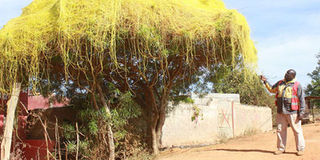Dodder plant poses threat to trees and crops

A tree in Wote town, Makueni County, invaded by field dodder. The dodder builds a canopy on the host plant and casts thousands of tendrils to form a dense spectacle before it strangles it. PHOTO | FILE | NATION MEDIA GROUP
What you need to know:
- According to scientists, the weed spreads mainly through contaminated crop seed, although vegetative spread is also possible.
- Kakamega Forest Senior Manager George Aimo said the Dodder plant is a major threat to trees and crops.
When Samuel Onyango, a smallholder farmer from Kisumu County, first noticed yellowish spaghetti-like leafless vines hanging loosely on his fence some three years ago, he did not bother about them.
Little did he know that it was a killer weed that would end up strangling his crops and even trees.
The weed, known as field dodder or Cuscuta japonica, whose origin has been traced to North America, is a parasitic plant; meaning that it draws nutrients from host plants and trees — suffocating them, sometimes to death.
“It is becoming a nightmare particularly in western Kenya, the Rift Valley and in parts of the Central region,” said Dr Eston Mutitu, a Senior Entomologist and Chief Research Scientist at the Kenya Forest Research Institute (Kefri).
The dodder builds a canopy on the host plant and casts thousands of tendrils to form a dense spectacle before it strangles it.
GERMINATION
According to scientists, the weed spreads mainly through contaminated crop seed, although vegetative spread is also possible.
“The biggest problem is that Cuscuta has hundreds of host plants, some of them are of great economic importance,” said Dr Mutitu.
“We have observed a huge impact on a wide range of plants and trees such as citrus, grevillea, euphorbia trees among many others,” he told the Nation.
The plant also affects crops such tomatoes, sweet potatoes, tea, and potatoes.
Unlike root parasites such as Striga which require a germination stimulant provided by host roots, scientists at the Centre for Agriculture and Bioscience International have observed that Cuscuta species have no specialised germination requirement.
KAKAMEGA FOREST
The weed is also said to be resilient to different climatic conditions and its seed can persist in dry soils for more than 10 years as it awaits a host.
“I have tried different kinds of chemicals from local agrovets, but the weed has survived the onslaught, thriving and killing host plants,” said Mr Onyango.
Kakamega Forest Senior Manager George Aimo said the Dodder plant is a major threat to trees and crops.
“It has preference of certain species, though we cannot rule out that it can affect other trees species. Though it has not yet attacked any species in Kakamega Forest, it is present on the forest fence,” said Mr Aimo.
The forester said that despite its short lifespan, the parasitic weed can easily damage a forest if not dealt with in time.
MITIGATION
Prof Matthew Dida, the Head of the Department of Agriculture at Maseno University, said that there are different kinds of Dodder species which can affect indigenous vegetables and trees.
“It is possible that the parasitic plant could evolve to affect other species that have not been under attack so far,” said Prof Dida, pointing out that the most affected tree species in western Kenya are in the family of the yellow oleander, usually preferred for live fencing.
According to Dr Mutitu, Kefri has started analysing the weed to understand the biology of host plants among other issues, with a view of coming up with a mitigation strategy.
“We are looking for a possibility of chemical control of the weed and in the long term biological control,” said Dr Mutitu.
“We are also exploring other avenues including positive uses of Cuscuta,” he said, referring to a new study published in the American Journal of Agriculture and Forestry, which suggests that the weed could be an important source of medicine.
AWARENESS
So far, farmers are using manual methods of control which include uprooting infested plants and burning them.
However, in other areas people who are yet to understand the weed preserve it particularly on their fences confusing it is a flower.
“There is need to sensitise the public on the impact of the Dodder weed,” said Ms Abigael Koech, a phytosanitary expert at the Kenya Plant Health Inspectorate.
Dodder’s many other names include love vine, knot weed, strangle weed, strangle vine, angel’s hair, gold-thread, devil’s ringlet, hell-bind, hair weed, devil’s hair, hail weed and witches’ shoelaces.
Additional reporting by George Odiwuor






